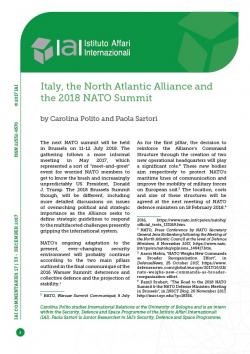Italy, the North Atlantic Alliance and the 2018 NATO Summit
Italy, the North Atlantic Alliance and the 2018 NATO Summit
Carolina Polito and Paola Sartori*
The next NATO summit will be held in Brussels on 11-12 July 2018. The gathering follows a more informal meeting in May 2017, which represented a sort of “meet-and-greet” event for worried NATO members to get to know the brash and increasingly unpredictably US President, Donald J. Trump. The 2018 Brussels Summit though, will be different, including more detailed discussions on issues of overarching political and strategic importance as the Alliance seeks to define strategic guidelines to respond to the multifaceted challenges presently gripping the international system.
NATO’s ongoing adaptation to the present, ever-changing security environment will probably continue according to the two main pillars outlined in the final communiqué of the 2016 Warsaw Summit: deterrence and collective defence and the projection of stability.[1]
As for the first pillar, the decision to reinforce the Alliance’s Command Structure through the creation of two new operational headquarters will play a significant role.[2] These new bodies aim respectively to protect NATO’s maritime lines of communication and improve the mobility of military forces on European soil.[3] The location, costs and size of these structures will be agreed at the next meeting of NATO defence ministers on 18 February 2018.[4]
Turning to the second strand, NATO has so far engaged in several actions to project stability on its Southern flank. On the one hand, the Alliance has joined the US-led anti-ISIS coalition, while, on the other, it engaged in several capacity-building activities with partners such as Jordan and Tunisia. The core aspects of these “defence capacity packages” are intelligence training, information sharing, border security and counter-terrorism measures.
Notwithstanding NATO’s commitment to the stabilization of the Mediterranean region, the rapidity and ubiquity of such threats continue to challenge the Alliance’s decision-making process both in terms of procedures and internal cohesion. In fact, NATO’s policies in the region remain a divisive topic. Eastern and Northern member states have different threat perceptions compared to Southern Allies, and the fluid and ever-changing nature of present developments in the Middle East and North Africa makes it more difficult to define a clear strategy, reinforcing a perception of NATO’s inability to address such threats. Therefore, the Atlantic Alliance will need to take further steps to reinforce its Mediterranean action in conceptual, political and military terms.
Italy has strongly encouraged an increased NATO presence in Europe’s Southern neighbourhood. For instance, recent Italian efforts contributed to the establishment of a “hub for the South” at the Alliance’s Joint Forces Command in Naples on 5 September 2017.[5] While representing a significant development, the hub constitutes only a first step toward the definition of more structured approach toward the region, as outlined by Italian Prime Minister Paolo Gentiloni at a seminar of the NATO Parliamentary Assembly’s Mediterranean and Middle East Special Group held in Rome in November 2017.[6]
In this regard, a better definition of national priorities would help Italy in promoting its strategic vision within NATO. This is even more important in light of the election of Stuart Peach, Chief of Defence Staff of the United Kingdom’s Armed Forces, as Chairman of the NATO Military Committee,[7] a development that could further boost the Alliance’s focus on the eastern and northern flank to the detriment of the South. Italy will therefore probably face an uphill battle in seeking to promote its strategic vision within NATO in the run-up to the Brussels Summit.
In order to achieve this objective, Italy should follow a twin-pronged approach. On the one hand, it should devolve more efforts to pursue the agreed threefold NATO pledge on burden sharing: “cash, capabilities, commitment”.[8] First, the gradual path towards the goal of spending 2 percent of national GDP on defence by 2024 should be undertaken, thereby demonstrating Italy’s willingness to honour its responsibilities. Second, the quality of defence expenditure should be improved by focusing on investments, training and operational expenses, so as to maximize output in terms of capabilities. Third, Rome should continue to ensure an adequate commitment to NATO’s pool of forces needed for both collective defence and the projection of stability – including crisis management operations and training missions.
In relation to such a commitment, the second line of action consists in capitalizing on Italy’s credibility – accrued through Rome’s continued and valuable participation in NATO international operations – to reinforce the national role within the Alliance. Hence, Rome could act as a rallying nation and help build consensus among Allies who share Italian concerns towards the South. In political terms, this could also be achieved by enhancing governmental support to the Italian representation within NATO institutions and related agencies.
Notably, the implementation of such initiatives should not be undermined by the outcome of Italy’s forthcoming general elections, thus further boosting Italian credibility while promoting a strong degree of continuity in defence and foreign policy planning.
Italy’s active participation in Europe’s recently established Permanent Structured Cooperation (PeSCo) could also have a positive carryon effect on its position within NATO. Overall, developments towards more effective European defence cooperation could produce beneficial outcomes for NATO. In fact, recent EU initiatives, including the European Defence Fund, could serve as a useful tool to overcome the European tradition of defence policy fragmentation and address the long-standing burden sharing issue.
Italy should therefore support France and Germany’s leadership role on European defence cooperation, joining these countries in actively promoting enhanced coordination in matters pertaining to European defence. Such a core group, with the desirable addition of Spain, would allow Italy to promote its strategic objectives of deepened European defence and close partnership with the US, two traditional pillars of Italian foreign and defence policy.[9] In so doing, the country would not only reinforce its position and reliability within the Atlantic Alliance, but also and conversely help improve Italian standing within EU institutions, as a stronger and more visible role in NATO decision-making would improve the perception of Italian reliability within the EU as well.
In an era defined by conflictual multipolarity, overlapping crises, hybrid threats and an increasingly erratic US administration, NATO will face numerous and urgent challenges, both foreign and domestic. It will be fundamental for the Alliance to find a compromise between Allies’ different and often diverging views and priorities, by taking into consideration all contemporary threats and contingencies. In this context, Italy could emerge to play a pivotal role as a balancer between East and West, North and South.
While abiding by its commitments and demonstrating its ability to act as a responsible and credible partner, Italy should capitalize on its military contribution to promote greater NATO engagement in projecting stability toward the Southern flank. To this end, the Alliance should build on on-going initiatives (i.e. capacity-building, maritime security operations and the creation of the “hub for the South”) to coordinate intelligence, counter-terrorism and defence capacity building efforts in the area. In so doing, Italy could benefit from the possibilities offered by PeSCo, a tool that could help to mutually reinforce both NATO-EU cooperation and Italy’s position and influence within both frameworks.
* Carolina Polito studies International Relations at the University of Bologna and is an intern within the Security, Defence and Space Programme of the Istituto Affari Internazionali (IAI). Paola Sartori is Junior Researcher in IAI’s Security, Defence and Space Programme.
[1] NATO, Warsaw Summit Communiqué, 9 July 2016, https://www.nato.int/cps/en/natohq/official_texts_133169.htm.
[2] NATO, Press Conference by NATO Secretary General Jens Stoltenberg following the Meeting of the North Atlantic Council at the level of Defence Ministers, 8 November 2017, https://www.nato.int/cps/en/natohq/opinions_148417.htm.
[3] Aaron Mehta, “NATO Weighs New Commands as Broader Reorganization Effort”, in DefenseNews, 25 October 2017, https://www.defensenews.com/global/europe/2017/10/25/nato-weighs-new-commands-as-broader-reorganization-effort.
[4] Kamil Szubart, “The Road to the 2018 NATO Summit & the NATO Defense Ministers Meeting in Brussels”, in INSCT Blog, 20 November 2017, http://insct.syr.edu/?p=18356.
[5] NATO, NATO Strategic Direction South Hub Inaugurated, 5 September 2017, https://www.nato.int/cps/en/natohq/news_146835.htm.
[6] More information as well as the video of the event are available on the WebTVCamera website: Assemblea NATO: Boldrini, Grasso e Gentiloni a seminario Gruppo speciale Mediterraneo e Medio Oriente, 23 November 2017, http://webtv.camera.it/evento/12230.
[7] NATO, Air Chief Marshal Sir Stuart Peach Elected as Next Chairman of the NATO Military Committee, 16 September 2017, https://www.nato.int/cps/ua/natohq/news_146922.htm.
[8] NATO, Doorstep Statement by NATO Secretary General Jens Stoltenberg ahead of the Meetings of NATO Foreign Ministers, 31 March 2017, https://www.nato.int/cps/en/natohq/opinions_142787.htm.
[9] Andrea Aversano Stabile, Alessandro Marrone and Carolina Polito, “Europa della difesa: quali prospettive?”, in Documenti IAI, No.17|19 (November 2017), p. 8, http://www.iai.it/en/node/8518.
-
Dati bibliografici
Roma, IAI, dicembre 2017, 4 p. -
In:
-
Numero
17|33




